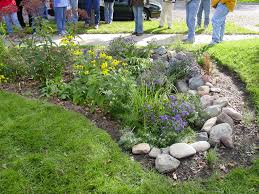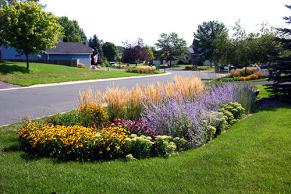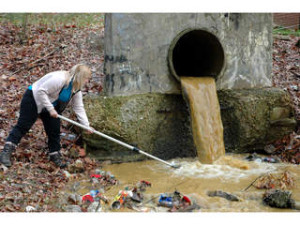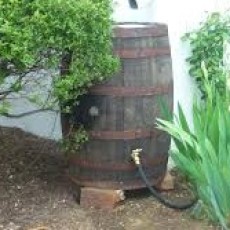WHAT YOU CAN DO TO HELP REDUCE THE STORMWATER THAT IS POISONING OUR WATERWAYS
Here are things you can do yourself to minimize runoff at your home, business, office, school, or house of worship. These measures can be installed alone or in a sequence to get the most benefit. Once runoff leaves your property there is no longer an opportunity to filter the pollutants before they go into the storm drain system and enter the nearest creek or stream.
Consider what our Bay would be like if each property owner had a goal to hold all of their stormwater on site to achieve “zero runoff”? Here’s what you can do to achieve this:
Stormwater rain barrel
1) Install rain cisterns or tanks or rain barrels to capture roof runoff to allow it to slowly infiltrate into your landscape beds or actively use it for irrigation. Nowadays there are a lot more aesthetically pleasing cisterns on the market which hold more gallons. Keep in mind that a 55-gallon rain barrel fills up very quickly in an average rain. Rain pumps are now available so that you can use the water more actively, say for watering container plants or vegetable gardens.
 Stormwater rain garden
Stormwater rain garden
2) Install rain gardens (also called bioretention cells) which are sunken depressions in the landscape which temporarily hold water from a downspout and allow it to infiltrate into the ground. Rain gardens are constructed with special soils and planted with water-loving vegetation – such as blue flag iris, white turtlehead, and cardinal flower. These lovely gardens improve water quality as they filter pollutants from the roof or pavement runoff. Curiously, rain garden plants thrive on the pollutants found in runoff thus there is a symbiotic relationship as nitrogen and phosphorus are the chemicals found in fertilizer. You also may redirect downspouts to existing planting beds.
Replace lawns
3) Replace turf (lawns) with conservation landscaping–also sometimes called “rainscaping” or “bayscaping”. Areas are planted with native trees, shrubs, flowering perennials and groundcovers such as sweetbay magnolia, winterberry, buttonbush, coneflower, gayfeather, and bluestar, some of which absorb up to 14 times more rainwater than a grass lawn thus reducing runoff. They also lessen the time and expense of mowing, watering, and fertilizing. They also offer greater visual interest than lawns–they are a lot prettier–and provide habitat for wildlife, especially birds.
 This year, homeowners are being asked to plant native wildflowers which attract bees, such as herbs, asters, bee balm, black-eyed Susans, goldenrod, as well as plants which draw monarch butterflies, such as milkweed, butterfly weed, Joe-Pye weed, and tall garden phlox. Monarch butterfly populations are at their lowest levels – the migratory population declined 40% in one year resulting in great concern about possible extinction.
This year, homeowners are being asked to plant native wildflowers which attract bees, such as herbs, asters, bee balm, black-eyed Susans, goldenrod, as well as plants which draw monarch butterflies, such as milkweed, butterfly weed, Joe-Pye weed, and tall garden phlox. Monarch butterfly populations are at their lowest levels – the migratory population declined 40% in one year resulting in great concern about possible extinction.
Minimize impervious surfaces
4) If you are building a new home, an addition, a new patio, or driveway you should try to minimize impervious cover by installing pervious concrete or pavers which allows rainwater to infiltrate into the ground thus producing no runoff. You can visit the butterfly garden at Quiet Waters Park to see pervious concrete paths and surfaces.
Don’t use chemical fertilizers
5) Fertilizer use is one of the most harmful pollution sources causing the serious infections you have seen and in the decline of the health of our creeks and streams and the Bay. Fertilizer causes dense algal growth which limits the amount of sunlight and reduces the oxygen available for fish, plants, and other aquatic life and causes the proliferation and acute toxicity of organisms leading to flesh-eating infections. Try not to use lawn fertilizers but instead spread leaf compost (e.g. Leafgro) throughout your beds and lawn. If you make your own compost, keep it covered so that you reduce the weed seeds and keep animals out. If you must use fertilizers, test your soil to determine the appropriate amount. If fertilizer falls onto driveways or sidewalks, sweep it up instead of hosing it away. Do not use fertilizers with phosphorus and only use the absolute minimum of nitrogen needed. Never apply fertilizer or pesticides before it rains.
Compost
7) Compost leaves and grass clippings. Alternatively, bag leaves and grass clippings and place at the curb for collection—not loose in the street. Doing this keeps leaves out of the gutter, where they can wash into the nearest storm drain. Do not cut your grass too short and use a mulching lawn mower, preferably electric, and leave the grass clippings in the lawn. This is nature’s age-old fertilizing
 Do not put leaves in the road – they will be carried to the nearest storm drain. Decomposing leaves are bad for water quality as they consume up to seven times more oxygen than when they decompose on land and are partially responsible for dead zones and fish kills due to the depletion of oxygen and the release of nitrogen, both of which are very harmful to aquatic life.
Do not put leaves in the road – they will be carried to the nearest storm drain. Decomposing leaves are bad for water quality as they consume up to seven times more oxygen than when they decompose on land and are partially responsible for dead zones and fish kills due to the depletion of oxygen and the release of nitrogen, both of which are very harmful to aquatic life.
Mulch
8) To hold moisture in the soil and reduce weeds, cover planting beds with 2-3” of hardwood mulch or pine fines (another type of mulch). Try to resist using black or orange mulch as they contain dyes which are also potentially harmful. Plant and stabilize bare spots to prevent erosion.
Don’t use pesticides
9) Do not use pesticides; instead use natural alternatives which are more readily available. Brands such as Safer®, Concern®, and Victor Poison-Free® are three organic insect controls recognized as world leaders in the organic plant disease control and organic gardening categories. They can be used indoors or outdoors and are safe around pets and children. Only apply any pesticide when rain is not forecasted.
Clean up after pets
10) Pick up after your pets and dispose of pet waste in the garbage. It is Maryland law! Pet waste produces approximately 1/3 of the bacterial pollution in our waterways and is carried there by runoff. Consider putting up a pet waste station in your neighborhood if it is a problem.
Don’t dump
11) Never dump or place anything such as paint or other chemicals, yard waste, or pet waste near stormwater drains—it will end up in the nearest creek or stream.
Add green roof
12) Consider a green roof on your home, garage or shed which will retain runoff and at the same time modulate temperatures in your home. Green roofs can be used in conjunction with solar panels and they hold runoff.
Maintain septic systems
13) If you have a septic system, maintain it properly by having it pumped every three to five years. Never put chemicals down septic systems, they can harm the system and seep into the groundwater. If it is an older system or is failing, replace it with a Best Available Technology nitrogen removing septic system. A County grant may be available to do this or to hook into public sewer service. Go to: http://www.aahealth.org/programs/env-hlth/well-septic-systems/brf
